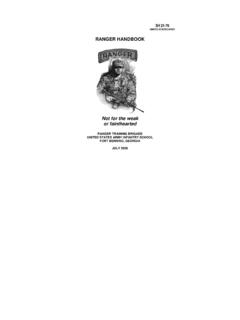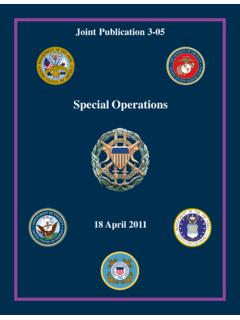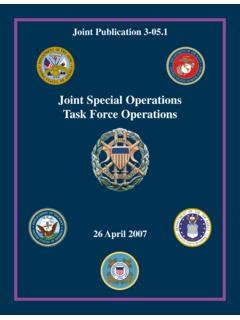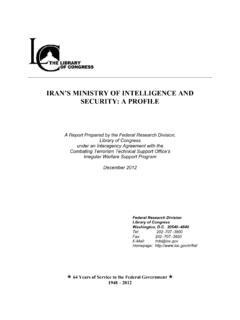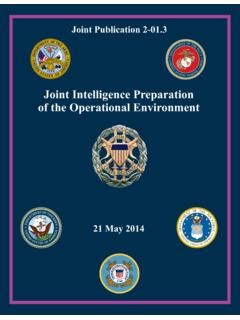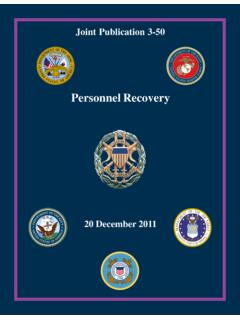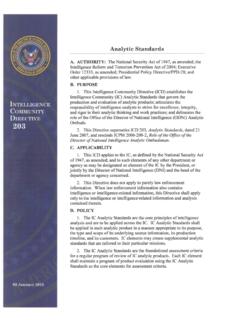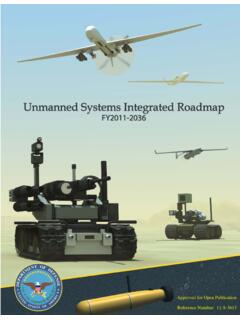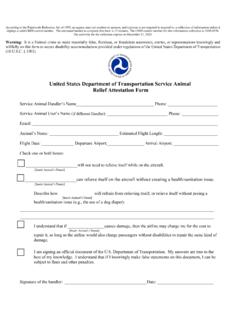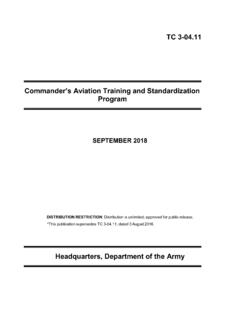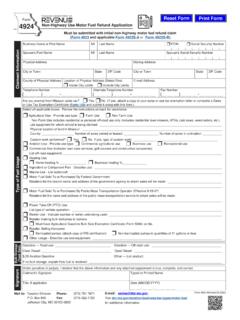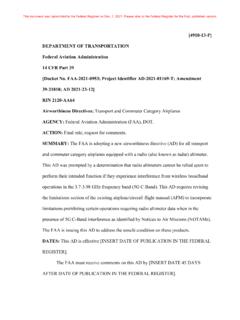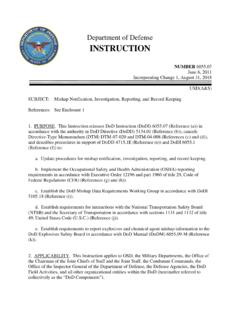Transcription of UAS ROADMAP 2005 - Federation of American Scientists
1 UAS ROADMAP 2005 UAS ROADMAP 2005 UAS ROADMAP 2005 EXECUTIVE SUMMARY As the Global War on Terrorism (GWOT) enters its fourth year, the contributions of unmanned aircraft (UA)* in sorties, hours, and expanded roles continue to increase. As of September 2004, some twenty types of coalition UA, large and small, have flown over 100,000 total flight hours in support of Operation ENDURING FREEDOM (OEF) and Operation IRAQI FREEDOM (OIF). Their once reconnaissance-only role is now shared with strike, force protection, and signals collection, and, in doing so, have helped reduce the complexity and time lag in the sensor-to-shooter chain for acting on actionable intelligence. UA systems (UAS) continue to expand, encompassing a broad range of mission capabilities. These diverse systems range in cost from a few thousand dollars to tens of millions of dollars, and range in capability from Micro Air Vehicles (MAV) weighing less than one pound to aircraft weighing over 40,000 pounds.
2 UA, and unmanned systems in general, are changing the conduct of military operations in the GWOT by providing unrelenting pursuit without offering the terrorist a high value target or a potential captive. As the department of Defense (DoD) develops and employs an increasingly sophisticated force of unmanned systems, including UA over the next 25 years (2005 to 2030), technologists, acquisition officials, and operational planners require a clear, coordinated plan for the evolution and transition of this capability. The overarching goal of this ROADMAP , in following the Strategic Planning Guidance (SPG), is to guide the Military Departments and defense agencies toward a logical, systematic migration of mission capabilities to this new class of military tools. The goal is to address the most urgent mission needs that are supported both technologically and operationally by various UAS.
3 Some DoD missions can be supported by the current state of the art in unmanned technology where the capabilities of current or near-term assets are sufficient and the risk to DoD members is relatively low. Other mission areas, however, are in urgent need of additional capability and present high risk to aircraft crews. These mission areas, highlighted in this ROADMAP , will receive significant near-term effort by the department . Each Service is developing a wide range of UAS capabilities, and the Office of the Secretary of Defense (OSD) is responsible for ensuring these capabilities support the department s larger goals of fielding transformational capabilities, establishing joint standards, and controlling costs. OSD is establishing the following broad goals to achieve key UAS capabilities. The organizations in parenthesis are those which must cooperatively engage to attain the stated goal.
4 1. Develop and operationally assess for potential fielding, a joint unmanned combat aircraft system capable of performing Suppression of Enemy Air Defenses (SEAD)/Strike/Electronic Attack/Intelligence Surveillance, and Reconnaissance (ISR) in high threat environments. (OSD, USAF, USN) 2. Field secure Common Data Link (CDL) communications systems for aircraft control and sensor product data distribution for all tactical and larger UA, with improved capability to prevent interception, interference, jamming, and hijacking. Migrate to Joint Tactical Radio System (JTRS)/Software Communications Architecture (SCA) compliant capability when available. (OSD, USA,USAF, USN, USMC) 3. Ensure compliance with the existing DoD/Intelligence Community Motion Imagery Standards Board metadata standard and profiles for all full motion video capable UA.
5 Operationally demonstrate and * This ROADMAP adopts the terminology unmanned aircraft (UA), rather than unmanned aerial vehicle (UAV), when referring to the flying component of an unmanned aircraft system. Unmanned Aircraft Systems (UAS) are the focus of this ROADMAP . This change in terminology more clearly emphasizes that the aircraft is only one component of the system, and is in line with the Federal Aviation Administration s decision to treat UAVs as aircraft for regulatory purposes. EXECUTIVE SUMMARY Page i UAS ROADMAP 2005 field near real time (<3 minutes) UAS meta data derived targeting capability for coordinate seeking weapons. (OSD, USAF, USA, USN, USMC) 4. Foster the development of policies, standards, and procedures that enable safe, timely, routine access by UA to controlled and uncontrolled airspace, to include: promoting the development, adoption, and enforcement of industry-wide airworthiness standards for the design, manufacturing, testing, and employment of UAS (OSD) coordinating with FAA procedures for operating DoD UA in unrestricted airspace comparable to those of manned counterparts ( , aircraft, light-sport aircraft, and radio-controlled model aircraft) (OSD) developing and fielding the capability for UA to see and autonomously avoid other aircraft, providing an equivalent level of safety to comparable manned systems (USAF, USA, USN, USMC) 5.
6 Improve Combatant Commander UAS effectiveness through improved joint service collaboration. (OSD, JFCOM, USAF, USA, USN, USMC) 6. Develop and field reliable propulsion alternatives to gasoline-powered internal combustion engines on UA, specifically their replacement with heavy fuel engines. (OSD, USAF, USA, USN, USMC) 7. Improve adverse-weather UA capabilities to provide higher mission availability and mission effectiveness rates. (OSD, USAF, USA, USN, USMC) 8. Ensure standardized and protected positive control of weapons carried on UA. Develop a standard UAS architecture including weapons interface for all appropriate UA. (OSD, USAF, USA, USN, USMC) 9. Support rapid integration of validated combat capability in fielded/deployed systems through a more flexible test and logistical support process.
7 (OSD, JFCOM, USAF, USA, USN, USMC) EXECUTIVE SUMMARY Page ii UAS ROADMAP 2005 TABLE OF CONTENTS Page iii TABLE OF CONTENTS 1 1 1 1 WHY UNMANNED AIRCRAFT? .. 1 Current 3 MAJOR UAS .. 4 CONCEPT EXPLORATION UAS .. 15 SPECIAL OPERATIONS UAS .. 20 SMALL 26 UNMANNED 32 UAS PROGRAMMATIC 37 UAS WORLDWIDE 38 41 HISTORICALLY VALIDATED UAS 41 COMBATANT COMMANDER REQUIREMENTS FOR UAS .. 41 MISSION REQUIREMENTS RANKED FOR 42 MISSION AREAS OPEN TO UAS .. 43 45 Technologies .. 47 PROCESSOR 48 COMMUNICATION 49 PLATFORM 51 PAYLOAD 56 Operations .. 63 63 OPERATIONAL CONCEPTS DEVELOPMENT PARTICIPATING 64 67 WEAPON 69 OPERATING AND SUPPORT 69 ROADMAP .
8 71 UAS CAPABILITIES 71 UAS MISSIONS 72 GOALS FOR UNMANNED 74 FUTURE 75 Appendix A: A-1 Appendix B: B-1 Appendix C: Communications .. C-1 Appendix D: Technologies .. D-1 Appendix E: Interoperability Standards .. E-1 Appendix F: Airspace ..F-1 Appendix G: Task, Post, Process, and Use Considerations .. G-1 Appendix H: H-1 Appendix I: Homeland Security .. I-1 UAS ROADMAP 2005 TABLE OF CONTENTS Page iv Appendix J: Unmanned Ground Vehicles .. J-1 Appendix K: Survivability .. K-1 LIST OF FIGURES AND TABLES FIGURE TIMELINE OF CURRENT AND PLANNED DOD UAS 3 FIGURE DOD ANNUAL FUNDING PROFILE FOR 37 FIGURE UAS MANUFACTURING COUNTRIES.. 40 FIGURE DOD INVESTMENT IN UAS RESEARCH AND DEVELOPMENT.. 47 FIGURE TREND IN UA AUTONOMY.. 48 FIGURE TREND IN PROCESSOR SPEED.
9 49 FIGURE RELATIONSHIPS OF PROCESSOR SPEED AND MEMORY.. 49 FIGURE MASS SPECIFIC POWER TRENDS.. 54 FIGURE MISHAP RATE 55 FIGURE UA CAPABILITY METRIC: WEIGHT V. COST.. 57 FIGURE UA PERFORMANCE METRIC: ENDURANCE V. 57 FIGURE UA PAYLOAD CAPACITY VS. ENDURANCE.. 58 FIGURE STILL IMAGERY SENSOR TECHNOLOGY FORECAST.. 59 FIGURE MOTION/VIDEO IMAGERY SENSOR TECHNOLOGY FORECAST.. 59 FIGURE RADAR IMAGERY SENSOR TECHNOLOGY 59 FIGURE SIGINT SENSOR TECHNOLOGY FORECAST.. 60 FIGURE MASINT SENSOR TECHNOLOGY FORECAST.. 60 FIGURE FORECAST SENSOR CAPABILITIES.. 60 FIGURE LOCATIONS OF DOD UAS.. 68 FIGURE UAS CAPABILITIES ROADMAP .. 72 FIGURE UAS MISSIONS ROADMAP .. 74 FIGURE C-1. GLOBAL HAWK COMMUNICATIONS ARCHITECTURE.. C-3 FIGURE C-2. PREDATOR OPERATING IN DEPLOYED C-4 FIGURE C-3.
10 PREDATOR REMOTE SPLIT OPERATIONS.. C-5 FIGURE C-4. UA PROGRESSION FROM CIRCUIT BASED TO NET-CENTRIC COMMUNICATIONS.. C-6 FIGURE C-5. JTRS GROUND AND AIRBORNE NETWORKS.. C-11 FIGURE C-6. THE TRANSFORMATIONAL COMMUNICATIONS C-12 FIGURE C-7. BLACK TRANSPORT C-13 FIGURE C-8. AIRCRAFT SYSTEMS ENGINEERING MODEL IP FRIENDLY NETWORK INTERFACES.. C-14 FIGURE C-9. SPIRALED STAGES TO A UA COMMUNICATIONS NETWORK.. C-20 FIGURE C-10. POTENTIAL CDL MIGRATION C-21 FIGURE C-11. CONSOLIDATED HIGH LEVEL PROGRAM SCHEDULE.. C-22 FIGURE D-1. PERFORMANCE PAYOFF OF A NOTIONAL COMBAT UA UTILIZING TECHNOLOGIES FROM THE JETEC PHASE III GOALS.. D-1 FIGURE D-2. JETEC COST GOAL IN COMPARISON TO EXISTING SYSTEMS.. D-2 FIGURE D-3. ENGINE EFFECTS ON TAKE-OFF GROSS WEIGHT FOR A DESIRED MISSION ENDURANCE.. D-5 FIGURE D-4.

